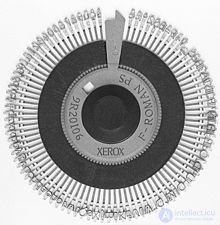Lecture


A petal printing device ( Daisy wheel printer (DWP)) is a printing device using impact printing technology. The device was invented in 1969 by David Lee from Xerox Corporation’s Diablo Data Systems division. DWP uses replaceable pre-formed element types, each of which is usually 96 characters long, to produce high-quality products comparable to quality typewriters, such as IBM Selectric, but two to three times faster [1] . DWP has been used in electronic typewriters, word processors, and printers since 1972.
By 1980, DWP had become the dominant technology for high-quality printing. Dot matrix printing and thermography printers are used where high speed is not required and poor print quality is acceptable. Both technologies were quickly replaced for most purposes, given that barcode printers, in particular laser printers, can print any characters or graphics, not limited to a narrow set of symbols, which allowed them to produce products of comparable quality [2] . Only some electronic typewriters are currently based on DWP technology.
By the principle of action were a hybrid of drum printers and a typewriter. Had one set of letters, located on the flexible petals of a plastic disc. The disk rotated, and a special electromagnet pressed the desired petal to the ink ribbon and paper. Since the character set was one, it was necessary to move the print head along the line, and the printing speed was noticeably lower than that of the drum printers. By replacing the disk with symbols, it was possible to get another font, but by inserting a non-black ribbon - to get a “color” print. For this purpose, a pause command could be present in the printer command set. [3] c.71 In addition to chamomile, the detail with the letters could have the shape of a thimble, (truncated) ball [3] c.53, or even a track chain.
Comments
To leave a comment
Electromechanical devices of electronic devices
Terms: Electromechanical devices of electronic devices